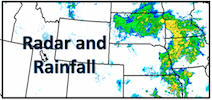
Radar and Rainfall
Posted on the CoCoRaHS site was a discussion how radar is used to measure precipitation
Radar and Rainfall
Radar is an acronym meaning Radio Detection and Ranging. During its initial development in WW II, weather was treated as “clutter”, a problem that kept radar operators from seeing enemy targets. Shortly after the end of the war, scientists realized the great benefit of using radar to study storms. The radar displayed previously unseen patterns of storm growth and structure. Doppler capabilities allowed for the detection of tornados and downbursts. Radar also showed its utility in estimating precipitation.
The traditional way of turning radar measurements into rainfall data is to relate the power returned from the cloud to the radar (meteorologists refer to this as the “radar reflectivity”) to some estimate of rain intensity measured on the ground. Once this so called Z-R relationship is determined, the radar data can be converted directly to rainfall over the entire coverage region of the radar. Usually, the rainfall estimates in the Z-R relationship come from rain gauge networks, like CoCoRaHS.
The great benefit of using radar is that it can estimate rainfall over a huge area, including most places where there are no rain gauges. However, it turns out that using radar to estimate rainfall is much more difficult than one might think for a number of reasons:
More information and links to information on radar and rainfall can be found on the CoCoRaHS web site by clicking here: “Radar” . . . oh, and don’t forget to view Pat Kennedy’s 2013 WxTalk Webinar on Radar: “WxTalk Radar”.
